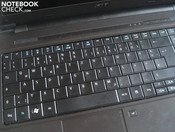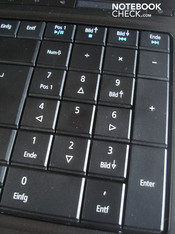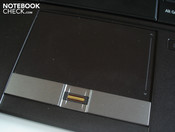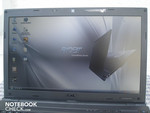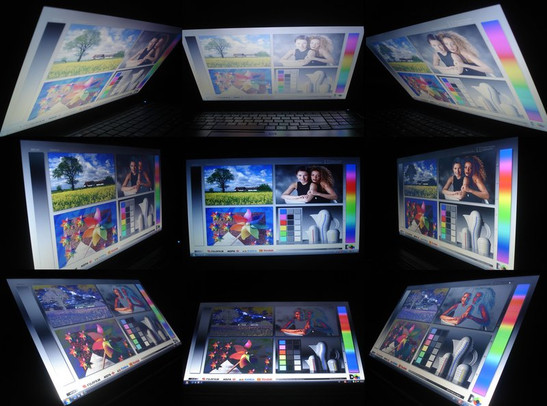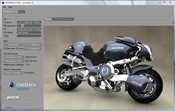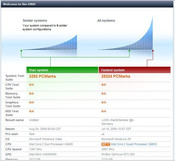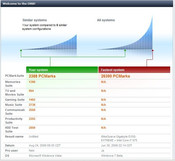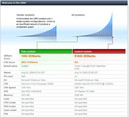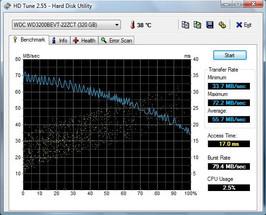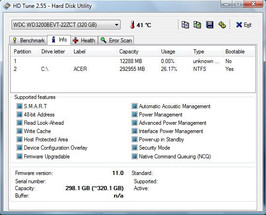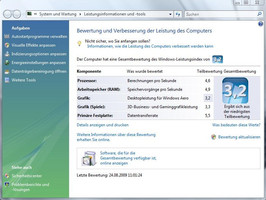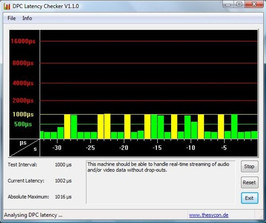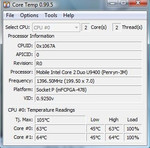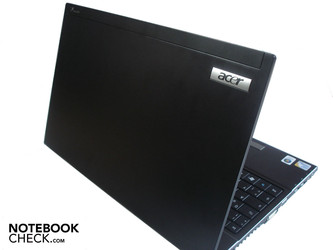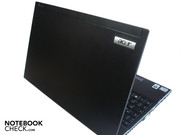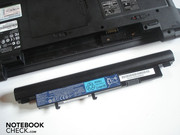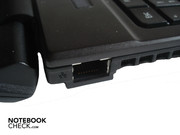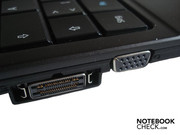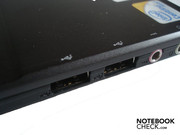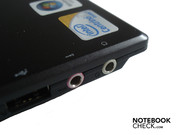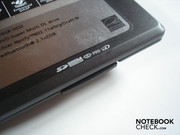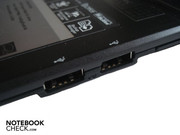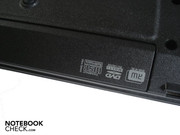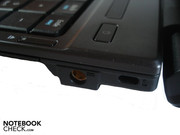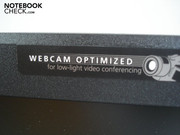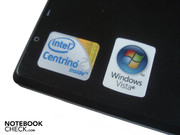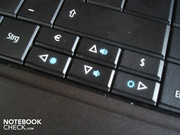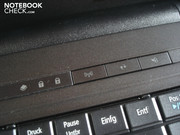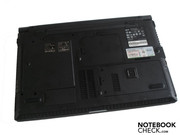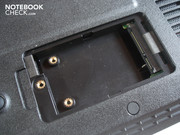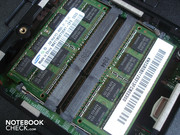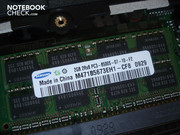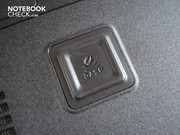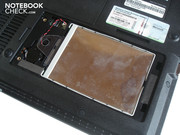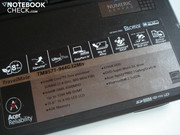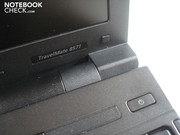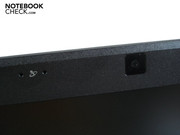Review Acer TravelMate 8571 Notebook
Endurance Runner?
With the TravelMate 8571, Acer brings a business model of its youngest Timeline range onto the market, which is supposed to impress with a battery life of even over eight hours remote from a socket. If Acer achieves its goal or if the TravelMate 8571 is already exhausted after halfway, can as always be read in our comprehensive review.
In the meantime, Acer has a notebook suitable for every taste in the Timeline range. It starts with the 1810T as the smallest and cheapest, which is already to be had for 500 Euros and bids an 11.6 inch display and an energy saving Core 2 Solo SU3500. Then follow the Aspire models 3810T (13.3 inches), 4810T (14 inches) and 5810T (15.6 inches). The price varies between 600 and 900 Euros depending on the processor (Core 2 Solo SU3500 or Core 2 Duo SU9400) and employed graphic card (Intel GMA 4500MHD or ATI Radeon HD 4330).
The Timeline Business alternative is brand-new, which shouldn't only be interesting for business people due to its matt display. We snatched the 900 Euros expensive top model, the TravelMate 8571-944G32Mn, which is equipped with a 15.6 inch display and a Core 2 Duo SU9400. The new TravelMates are, however, already available for around 600 Euros with a smaller display and a weaker Core 2 Solo SU3500.
Case
Acer sets on timeless simplicity for the light 2320 gram case. In regards to color, the surface is kept in a mixture of matt black and grey and, therefore, also barely attracts any fingerprints.
As to design, the TravelMate 8571 is a bit angular, but looks handy and stylish because of its low height of maximally three centimeters, anyway. Looking closer at the case it's notable that the applied materials make a high-quality impression, far off from the cheap plastic "look and feel" of other models from respective manufacturers.
The workmanship is excellent, too. There weren't any uncleanly manufactured areas or sharp edges to be established in the test. Additionally, the stability is impressive. Surprisingly, barely any image distortions could be provoked on the very thin display lid even with a stronger pressure. The rest of the case scarcely gives in, also; merely the area around the DVD drive on the bottom side is slightly billowy.
The hinges are quite stable and do their job reliably. But the case lifts extremely at opening the lid. Despite its 15.6 inch display, the 378 mm x 255 mm x 30 mm (breadth x depth x height) sized TravelMate 8571 looks very compact.
Connectivity
Just like for the design, Acer has limited itself to the vitals in view of connectivity. On the left are, aside from a RJ-45 gigabit LAN connection, a docking port, a VGA-out, two USB 2.0 ports, also two audio connections (microphone-in, headphone-out) found.
Merely a 5-in-1 cardreader has been placed on the front, which is proficient of SD, XD, MMC, MC and MS Pro formats. Finally, two further USB 2.0 ports wait on the right so that the TravelMate 8571 has a total of four USB ports. Conclusively, a DVD burner, the power socket and a Kensington lock are found.
Wireless connections are built up by the integrated WLAN 802.11 a/b/g/n, respectively Bluetooth 2.1. Furthermore, the TravelMate 8571 has a webcam with the resolution 640 x 480 (@ 30fps) and two built-in microphones for a better recording quality right away. Additionally, a fingerprint scanner takes care of security, which is placed beneath the touchpad and an "Anti-Shock-Protection-System" that should protect the hard disk against impacts. Two included programs are worth a special mention in view of software: Movie fans will be pleased about WinDVD 8, whereas important data can be easily secured with the BackUp Manager.
The port distribution didn't appeal to us as much, though. Most connections are found on the lateral edge's front half and are thus quickly accessible; connected cables around the device are often in the way and disturb beside the notebook. Also, the cables aren't fixed optimally in the sockets and wiggle extremely at touch. The meager variety also disappointed us. Especially the missing HDMI, respectively the DVI port, left a nasty taste in our mouths, as the image quality via VGA on external monitors looses vibrancy, fidelity and sharpness.
Input Devices
The input devices present one of the Acer TravelMate's bigger strengths. The keyboard has a superb sturdiness and barely gives in even under stronger pressure. Additionally, the good pressure point and the pleasant typing noise, which doesn't lack the necessary feedback, are impressive. Typing is an overall enjoyable experience because the keys, with exception of the arrow and F keys, have an adequate size. Practical: Acer has built-in extra keys for the Euro and Dollar sign.
The touchpad is on par and can almost score across the board. The size is alright and the smooth surface supplies a very good gliding feel. Additionally, there is a marked scrollbar and an own key for deactivating the touchpad. Unfortunately, the touchpad has been placed a bit too far left for our taste and hence is sometimes triggered unintentionally.
Both mouse keys beneath the touchpad round up the complete package perfectly. As the keyboard, they have a good pressure point and emit a sufficient acoustic feedback.
The TravelMate 8571 doesn't have a touch sensitive bar with hotkeys; instead there are three function buttons above the keyboard. While the first key activates or rather deactivates WLAN, the second key starts a BackUp operation for securing important data. The third key starts the PowerSaving function and supports energy saving, which contributes significantly to increasing the battery life.
Display
The display made a mediocre impression, despite LED backlight. For instance, due to an average luminosity of 168.8 cd/m2, the 15.6 inch HD screen isn't exactly bright with its resolution of 1366 x 768 pixels. The black value of 1.25 cd/m2 is also too high on the one hand, and on the other, the contrast of 146:1 too low, which results in a relatively pallid and colorless image. As this is usually not a problem in office mode, this flaw becomes negatively evident in movies or pictures. Merely the illumination of 80% and the good interpolation down to a resolution around 640 x 480 are felicitous.
| |||||||||||||||||||||||||
Brightness Distribution: 80 %
Center on Battery: 182 cd/m²
Contrast: 146:1 (Black: 1.25 cd/m²)
On the other hand, the fact that Acer uses a matt display delighted us especially. Thus, there are barely any reflections indoors and the TravelMate 8571 can be used well outdoors, too. If the brightness of the display, which scarcely decreases in battery mode, were a bit higher, outdoor use could be even more fun.
A further problem of the display is the disappointing viewing angle stability. Particularly on the vertical axis discoloration and brightness deviations turn up quickly. The screen presents itself far more stable in the horizontal viewing area.
Performance
In order to keep the promise of an over eight hour battery life, Acer has looked more on low power consumption rather than high performance in selection of components. A Core 2 Duo SU9400 is employed as a CPU, which has an excellent maximum TDP of 10 watts, but is only clocked with 1.4 GHz (3 MByte L2-Cache, 800 MHz FSB).
In comparison: A Core 2 Duo P7300, which is often used in equally expensive notebooks, definitely clocks higher with 2.00 GHz, but devours more than twice as much energy with a maximum of 25 watts (3 MByte L2-Cache, 1066 MHz FSB).
Acer also sets completely on the power efficiency of the RAM and treats the TravelMate 8571 four GBytes of energy saving DDR3 RAM. Two modules with a capacity of 2 GBytes each already occupy both available slots in Intel’s GS45 chip set mainboard. There are merely about 3 GBytes technically available due to the 32 bit operating system (Windows Vista Business), though. For those who would rather use Window XP can spare themselves the extra purchase because Acer already includes a downgrade to Window XP Professional (Recovery). The drive supply for this should, therefore, be just as unproblematic.
Acer restricts itself to an integrated Intel solution for the graphic card. The GMA 4500MHD is proficient of DirectX 10, but only clocks with 475 MHz and shares up to 1244 MBytes with the RAM. The performance of the GMA 4500MHD is very restricted and falls considerably in comparison to other onboard solutions like the G 102M or the 9400M G. Due to its decoding capability it can, however, be used well as a multimedia card because it supports the CPU in computing high resolution videos.
Let's now look at our benchmark course and start with the CPU-biased benchmarks. The Dual Core CPU SU9400 struggled decently already in the Cinebench R10. Thus, it resulted in only a meager 1665 points in single-core rendering, whilst the multi-core rendering ran through with 2897 points. The TravelMate 8571 reached 3292 points in the PCMark05, whereas only 2388 points were possible in the PCMark Vantage. In comparison: The alternative single-core CPU SU3500 that is, as already mentioned, used in other Timeline range models, is considerably slower in both the 3DMark05 (2197 points) as well as in the PCMark Vantage (1647 points), which should even be evident in normal office mode.
The 3DMark01 still ran fairly smooth with a total of 4213 points, whereas the 3DMark03 with 1879 points and the 3DMark05 with 1003 points mostly just visibly studdered along. In comparison: Nvidia's G 102M is more than twice as fast with 10749 points (3DMark01), 4360 points (3DMark03) and 2727 points (3DMark05). We have refrained from using newer 3DMark versions due to the poor graphic performance.
We did dare to do the practical gaming test though and ran both the integrated benchmarks from Half Life 2: Lost Coast and Counter Strike Source with a resolution of 1024 x 768. Thus, HL2 studdered along unplayably in low (18.3 fps), medium (17.5 fps) as well as in high details (16.3 fps). Nvidia's G 102M is four times as fast in high details with an average of 60.7 fps. In return, Counter Strike Source ran significantly better. Thus, a smooth 37.0 fps was achieved even in high details. Nvidia's G 102M still computes more than twice as fast, anyway. Finally, Left 4 Dead came to use, with which we used the Fraps tool to measure the refresh rates in-game. Very high details and a resolution of 1024 x 768 led to reproducible crashes, whereas low details and a resolution of 640 x480 still showed 26.4 fps. Once again, the comparison to the G 102M: This achieved a far higher 68 fps at the same settings.
Hence, the TravelMate 8571 is barely suitable for gaming, only older and more undemanding tracks run smoothly in higher details. The TravelMate 8571 is, admittedly, not conceived for gamers but the given performance is somewhat disappointing anyway, because, as it can be seen, other integrated graphic cards such as Nvidia's G 102M managed to conjure up significantly better results onto the display. The priority has been set here, once again, in favor of a low power consumption.
A 320 GByte sized model from Western Digital with 5400 rpm has been employed as a hard disk, which values we checked with the HDTune tool. The average access rate was a good 55.7 MB/s, whereas the minimum was 33.7 MB/s and the maximum 72.2 MB/s. The access time was good with 17.0 MB/s, the throughput rate was, contrarily, rather mediocre with 79.4 MB/s.
The TravelMate 8571 didn't score very well in Windows Vista performance index. The CPU (4.6), the RAM (4.9) and the hard disk (5.5) still achieved fairly good results. In return, Windows assessed the graphic card with only 3.2 (graphics) and 3.3 (graphics games) points.
With help from the DPC Latency Checker tool, we also checked the latencies under Windows. If these are too high, it can come to problems at connecting external devices (for example sound crackling with external sound cards). The TravelMate 8571 does well in this respect, the latencies reached roughly 1000 µs at most and is, therefore, still in an unproblematic field.
Verdict: Generally, the application performance is alright. It's not to be compared to the Timeline models with a single-core CPU SU3500, where it could already came to massive declines in low office load and Windows generally reacted very sluggish. Basically, Windows still works with the built-in Dual Core CPU SU9400 slower than comparably expensive notebooks with a stronger Core 2 Duo (like the popular CPUs: T3400, T4200/4300, T6400/6500/6600, P7350 or P8400/8600). For average office application this should be tolerable.
| 3DMark 2001SE Standard | 4213 points | |
| 3DMark 03 Standard | 1879 points | |
| 3DMark 05 Standard | 1003 points | |
Help | ||
| PCMark 05 Standard | 3292 points | |
| PCMark Vantage Result | 2388 points | |
Help | ||
Emissions
System Noise
Except for the loud drive, the TravelMate 8571 impresses to a great extent in regards to noise development. Thus, a maximum of 31.5 dB(A) is reached in idle mode. Under load it's even then a insignificantly higher 32.0-33.0 dB(A). The hard disk is also exemplary quiet with 32.9 dB(A). Hence, the notebook is always very quiet, not at least due to the pleasant fan noise.
The integrated DVD burner turns up decently, in opposition. While DVD rendering reaches a value of 35.7 dB(A) and is still halfway alright with that, a high and almost disturbing 46.0 dB(A) is reached at data access.
Noise level
| Idle |
| 31.5 / 31.5 / 31.5 dB(A) |
| HDD |
| 32.9 dB(A) |
| DVD |
| 35.7 / 46 dB(A) |
| Load |
| 32 / 33 dB(A) |
 | ||
30 dB silent 40 dB(A) audible 50 dB(A) loud |
||
min: | ||
Temperature
In return, there's barely anything to be criticized as to the temperature development. In idle mode (two hours runtime + maximum energy savings options) the case's bottom side only heated up to a maximum 34.9°C, whilst the upper side stayed slightly cooler with a maximum of 33.2 °C. In return, under load (one hour Furmark + Prime95) the bottom side heated up to a maximum of 42.7°C, whereas the upper side reached a cooler 39.1°C. Especially the wrist rests were subjectively striking, which heats up slightly to average but not at all disturbing. The bottom side's temperature can get a bit unpleasant after a while when the TravelMate 8571 is used on the lap. Finally, the small adapter stayed within a limit with a maximum of 48.4°C. The evaluations were all made at a room temperature of 24.0°C.
Let's take a look under the TravelMate 8571's hood. We can see that the CPU's temperature always stays within an uncritical range. While it reaches around 45°C in idle mode, it is a high but still unalarming 65°C under load. The hard disk has a standard temperature of roughly 40°C. The GPU temperature regrettably couldn't be established even with use of various tools.
(+) The maximum temperature on the upper side is 39.1 °C / 102 F, compared to the average of 34.3 °C / 94 F, ranging from 21.2 to 62.5 °C for the class Office.
(±) The bottom heats up to a maximum of 42.7 °C / 109 F, compared to the average of 36.8 °C / 98 F
(+) In idle usage, the average temperature for the upper side is 30.5 °C / 87 F, compared to the device average of 29.5 °C / 85 F.
(+) The palmrests and touchpad are cooler than skin temperature with a maximum of 31.8 °C / 89.2 F and are therefore cool to the touch.
(-) The average temperature of the palmrest area of similar devices was 27.6 °C / 81.7 F (-4.2 °C / -7.5 F).
Loudspeakers
The TravelMate 8571 has two small loudspeakers, which are placed inconspicuously above the keyboard. Their sound ranges on average with the major part of the notebook. Thus, the pitch ranges are halfway well mixed, whereas the low frequencies are slightly weak and the high ones fray a bit. Bass is existent but relatively faint and indistinct. The sound seems overall a bit tinny and it's definitely shy of volume. But the sound is still sufficient for the one or other movie in-between.
Battery Life
Now we come to the TravelMate's true strength, this being its long battery life. Thus, 2 hours and 58 minutes are already possible with load and maximum brightness (BatteryEater's Classic Test). This is already more than other notebooks can perform in idle mode at minimum brightness.
The battery capacity reached 4 hours and 5 minutes at DVD rendering and maximum brightness, which corresponds to about two movies. The notebook managed a long 5 hours and 45 minutes at internet surfing via WLAN, maximum brightness and medium energy savings mechanisms. The maximum runtime (BatteryEater's Reader's Test) of the six cell battery (56 Wh) was even an enormous 9 hours and 21 minutes before the TravelMate 8571 had to go back to a plug. Acer has kept its promise of making a very long battery life of over 8 hours possible with that - a ripe performance.
The other Timeline models 3810T (13.3 inches) and 4810T (14 inches) tested by us reached a 30% longer runtime on average, which is partly due to the smaller displays and partly due to the single-core CPU SU3500. We would, however, definitely take the dual-core alternative after the direct comparisons due to the higher performance. Because Windows XP is significantly more resource saving than Window Vista, the single-core CPU with Windows XP should also suffice at low demands.
| Off / Standby | |
| Idle | |
| Load |
|
Key:
min: | |
Verdict
The TravelMate 8571 leaves an overall convincing impression. The workmanship is on a very high level and the design is striking through its simplicity. The input devices barely give in and work precisely. Furthermore, the low temperature and the low noise development are pleasing. The biggest asset is the excellent battery life of more than 9 hours, though. Thus, the TravelMate 8571 advances to the perfect mobile escort with its compact dimensions and low weight. Because a matt display is used, there is nothing standing in the way of an extended excursion.
The TravelMate 8571 is, despite its advantages, not unfettered from flaws. Hence, the sound as well as the given performance is rather average. The connectivity turns out rather meager, especially the missing HDMI port is disadvantageous. However, the biggest critique point is the mediocre display with its low brightness and its weak contrast.
Basically, we can recommend the TravelMate 8571 to private and business users, who are looking for an office notebook for work, studies or vacation that is as mobile as possible. For those, however, who not only value a long battery life but a high performance as well, should look for an alternative with a faster processor and stronger graphic units.








